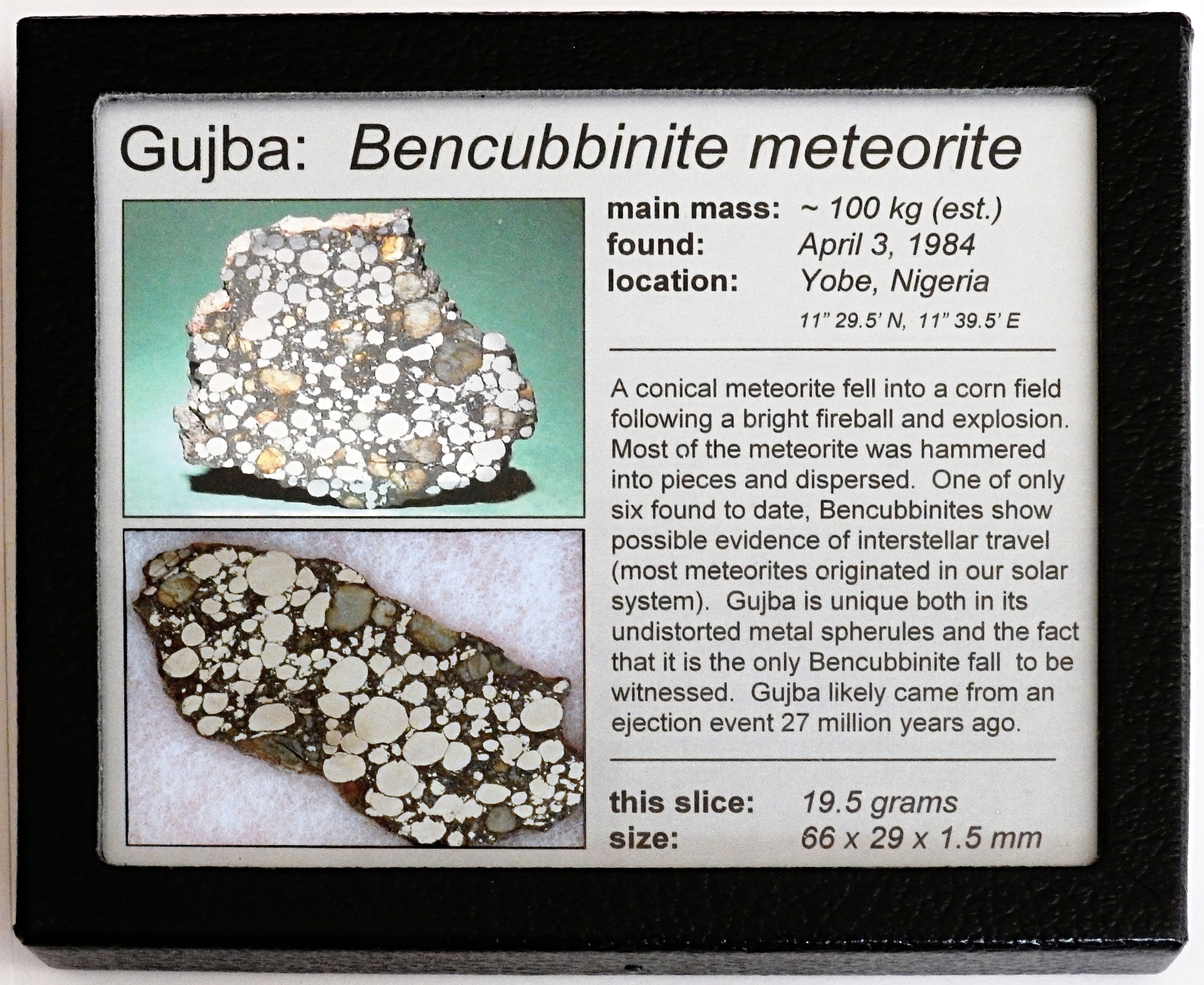|
Roll Overs:
#1
#2
#3
#4
#5
#6
#7
|

|
|
Copyright (c) Steve Brittenham.
|
19.5 grams. CB3a
TKW 100 kg. Observed 3 April 1984, near the village of Bogga Dingare, Nigeria.
  
Steve writes:
At about 6:30 PM local time on April 3, 1984, witnesses near the village of Bogga Dingare in Yobe, Nigeria saw a bright fireball moving west to east. Following an explosion, a conical meteorite fell onto a corn field. The local people hammered the meteorite into many pieces and most of the material was dispersed, but second-hand reports suggest the main mass may have weighed approximately 100 kg.
Gujba is a beautiful – though hard to photograph – example of a bencubbinite meteorite. Bencubbinites are unusual stony-iron meteorites composed of roughly equal amounts of iron, nickel, and ferromagnesian silicates; with nickel-iron content often surpassing 50 percent, they might otherwise be considered stony-irons were it not for their mineralogical and chemical properties that clearly put them into the carbonaceous chondrite clan. In fact, while the 1930 Bencubbin meteorite is the namesake for the bencubbinite class of carbonaceous chondrites, it was originally thought to be a stony-iron mesosiderite (some argue that because Bencubbin wasn’t reclassified until after Gujba’s discovery and classification, the rules of the nomenclature committee at the time should have made Gujba the actual namesake for this clan).
A primitive polymict chondritic breccia, Gujba is full of largely spherical nodules. Approximately 60% are metal with diameters typically ranging from 1.5 to 8 mm. The majority of the rest are cryptocrystalline silicate spheroids 1 to 15 mm in diameter, many with fan-like aggregates of pyroxene and olivine. There are currently only 7 recognized bencubbinites, with Gujba being the first and currently only actual witnessed fall from this rare class.
Bencubbinites show evidence of violent planetary-sized impacts and contain some of the most primitive solar system materials, making these CBa chondrites valuable records of early nebular processes. In Gujba, adjacent metal chondrules have different nickel contents and show no evidence of zoning. That, in combination with the presence of glass in some barred olivine chondrules, suggests Gujba accreted cold and didn’t experience high degrees of thermal metamorphism. Further, the slight elongation of the metal and silicate chondrules, and the deformed olivine bars in some of the latter, indicate parts of Gujba were plastically deformed, possibly from heating during compaction and accretion or during impact heating following accretion.
Because Gujba’s metal is not consistent with traditional nebular condensation models, some researchers have theorized it may instead be the result of a protoplanetary impact between an undifferentiated carbonaceous chondrite mass and a metal- and silicate-rich planetesimal. They speculate that high partial pressures in the resulting vapor cloud generated a metal-enriched gas that subsequently condensed as liquid metal, which subsequently sorted themselves by size and density. And while formation within our solar system is the most likely explanation for its origin, there are some indications that Gujba may instead be an interstellar meteorite.
Photo 1 shows our 19.5 gram slice in a standard 5x6 inch Riker mount display I created many years ago when exhibiting several meteorites at a local rock show (sorry for the poor picture, but because of the reflective glass, the photo had to be taken at an angle and then perspective-corrected in software). Photo 2 shows the slice next to a 1 cm cube; since the glancing angle that avoided metal reflection also gave that metal an odd color, Photo 3 was included to better show its natural coloration, but at the expense of the silicate material (Photo 4 is a similar shot of the unpolished back side). Photos 5 through 7 magnify some of the silicate material in this slice. |
Click to view larger photos
#1
#2
#3
#4
#5
#6
#7
|
Found at the arrow (green or red) on the map below
|
|
| |
Paul Kurimsky
4/5/2021 3:06:38 PM |
What a beautiful specimen! |
Juergen / jnmczurich
4/4/2021 4:13:03 PM |
Hi Steve
I like your images and your description of the Gujba meteorite very much. There are interesting information I didn't know till now. Very special meteorite. Thanks for sharing with us. |
Kenneth Regelman
4/4/2021 2:33:43 PM |
Wonderful Images it works great now . Thank you ! |
Paul Kurimsky
4/4/2021 12:51:50 PM |
What a beautiful specimen! |
Mike Murray
4/4/2021 12:30:10 PM |
I will echo what Steve wrote, Thank you Paul.
Quite the meteorite piece Steve. Thanks for sharing the pictures. |
Steve Brittenham
4/4/2021 12:21:19 PM |
No worries, Paul. You do the MPOD on your free time as a favor to the meteorite-collecting public. Your generosity is greatly appreciated. The occasional mistake is trivial compared to the benefit we all receive from your efforts! |
Paul Swartz
4/4/2021 11:18:49 AM |
The Idiot Programmer (IP), again!
Apologies to all, especially to Steve Brittenham. He submitted this for the April 3 anniversary fall but graciously stepped aside so we could all see Treysa, and this pathetically botched MPOD was his reward :(
We are considering flaying the !$%#* fool. |
Kenneth Regelman
4/4/2021 8:45:33 AM |
To whom it may concern >
The images are just blank white screens ! |
Andi Koppelt
4/4/2021 5:57:26 AM |
Help! |
Bernd Pauli
4/4/2021 4:54:31 AM |
The invisible Gujba Easter Egg ;-) |
matthias
4/4/2021 3:03:52 AM |
I understand. We have to hunt for the Easter Egg : - ) |
| |
|